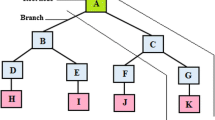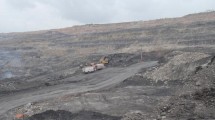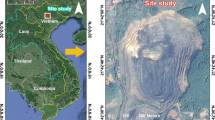Abstract
Drilling and blasting is an extensively used method for the rock fragmentation in surface mines and tunneling projects. Ground vibration is one of the most important environmental effects produced by blasting operations. In this research work, classification and regression tree (CART), multiple regression (MR), and different empirical models are used to develop predictions for ground vibrations induced by blasting operations conducted in the Miduk copper mine, Iran. To achieve this aim, a number of 86 blasting events were monitored, and the values of peak particle velocity (PPV) in terms of millimeter per second and two effective parameters on the PPV, namely, distance between blast-face and monitoring station in terms of meter and maximum charge used per delay in terms of kilogram, were measured. Performance of models established was evaluated using coefficient of correlation (R 2), Nash and Sutcliffe (NS), and root mean square error (RMSE). The results revealed that the CART technique with R 2 = 0.95, NS = 0.17, and RMSE = 0.17 provides a better performance when compared with empirical and MR models and has the capacity to generalize.







Similar content being viewed by others

References
Bhandari S (1997) Engineering rock blasting operations. AA Balkema, Rotterdam
Singh TN, Verma AK (2010) Sensitivity of total charge and maximum charge per delay on ground vibration. Geomat Nat Hazards Risk 1(3):259–272
Ghasemi E, Sari M, Ataei M (2012) Development of an empirical model for predicting the effects of controllable blasting parameters on flyrock distance in surface mines. Int J Rock Mech Min Sci 52:163–170
Monjezi M, Ahmadi Z, Yazdian Varjani A, Khandelwal M (2013) Backbreak prediction in the Chadormalu iron mine using artificial neural network. Neural Comput Appl 23:1101–1107
Verma AK, Singh TN (2013) Comparative study of cognitive systems for ground vibration measurements. Neural Comput Appl 22:341–1643
Trivedi R, Singh TN, Gupta N (2015) Prediction of blast-induced flyrock in opencast mines using ANN and ANFIS. Geotech Geol Eng. doi:10.1007/s10706-015-9869-5
Hasanipanah M, Monjezi M, Shahnazar A, Jahed Armaghani D, Farazmand A (2015) Feasibility of indirect determination of blast induced ground vibration based on support vector machine. Measurement 75:289–297
Jahed Armaghani D, Hasanipanah M, Mohamad ET (2015) A combination of the ICA-ANN model to predict air overpressure resulting from blasting. Eng Comput. doi:10.1007/s00366-015-0408-z
Hasanipanah M, Jahed Armaghani D, Khamesi H, Bakhshandeh Amnieh H, Ghoraba S (2015) Several non-linear models in estimating air-overpressure resulting from mine blasting. Eng Comput. doi:10.1007/s00366-015-0425-y
Khandelwal M, Singh TN (2006) Prediction of blast induced ground vibrations and frequency in opencast mine-a neural network approach. J Sound Vib 289:711–725
Khandelwal M, Singh TN (2007) Evaluation of blast-induced ground vibration predictors. Soil Dynamic Earthq Eng 27:116–125
Hajihassani M, Jahed Armaghani D, Monjezi M, Tonnizam Mohamad E, Marto A (2015) Blast-induced air and ground vibration prediction: a particle swarm optimization-based artificial neural network approach. Environ Earth Sci 74(4):2799–2817
Kuzu C (2008) The importance of site-specific characters in prediction models for blast-induced ground vibrations. Soil Dyn Earthq Eng 28:405–414
Khandelwal M, Kumar DL, Yellishetty M (2011) Application of soft computing to predict blast-induced ground vibration. Eng Comput 27(2):117–125
Fouladgar N, Hasanipanah M, Bakhshandeh Amnieh H (2016) Application of cuckoo search algorithm to estimate peak particle velocity in mine blasting. Eng Comput. doi:10.1007/s00366-016-0463-0
Singh TN, Singh V (2005) An intelligent approach to prediction and control ground vibration in mines. Geotech Geolog Eng 23:249–262
Khandelwal M, Singh TN (2009) Prediction of blast-induced ground vibration using artificial neural network. Int J Rock Mech Min Sci 46:1214–1222
Monjezi M, Hasanipanah M, Khandelwal M (2013) Evaluation and prediction of blast-induced ground vibration at Shur River Dam, Iran, by artificial neural network. Neural Comput Appl 22:1637–1643
Langefors U, Kihlstrom B (1963) The modern technique of rock blasting. Wiley, New York
Ambraseys NR, Hendron AJ (1968) Dynamic behavior of rock masses: rock mechanics in engineering practices. Wiley, London
Dowding CH (1985) Blast vibration monitoring and control. Prentice-Hall, Englewoods Cliffs, pp 288–290
Rai R, Singh TN (2004) A new predictor for ground vibration prediction and its comparison with other predictors. Indian J Eng Mater Sci 11(3):178–184
Jayraj Singh AK, Verma Haider Banka, Singh TN, Maheshwar Sachin (2016) A study of soft computing models for prediction of longitudinal wave velocity. Arab J Geosci 9(3):1–11
Iphar M, Yavuz M, Ak Hakan (2008) Prediction of ground vibrations resulting from the blasting operations in an open-pit mine by adaptive neuro-fuzzy inference system. Environ Geol 56:97–107
Verma AK, Singh TN (2013) Comparative study of cognitive systems for ground vibration measurements. Neural Comput Appl 22(Suppl 1):S341–S350
Hajihassani M, Jahed Armaghani D, Marto A, Tonnizam Mohamad E (2014) Ground vibration prediction in quarry blasting through an artificial neural network optimized by imperialist competitive algorithm. Bull Eng Geol Environ. doi:10.1007/s10064-014-0657-x
Breiman L, Friedman J, Olshen R, Stone CJ (1984) Classification and regression Trees. Wadsworth, Belmont
Tiryaki B (2008) Predicting intact rock strength for mechanical excavation using multivariate statistics, artificial neural networks, and regression trees. Eng Geol 99:51–60
Coimbra R et al (2014) Regression trees for modeling geochemical data—an application to Late Jurassic carbonates (Ammonitico Rosso). Comput Geosci 73:198–207
Kisi O et al (2016) Daily pan evaporation modeling using Chi squared automatic interaction detector, neural networks, classification and regression tree. Comput Electron Agric 122:112–117
Therneau TM, Atkinson EJ (1997) An introduction to recursive partitioning using the RPART routines. Technical report 61. Rochester: Section of Biostatistics, Mayo Clinic, http://www.mayo.edu/hsr/techrpt/61.pdf
Therneau TM, Atkinson B, Ripley MB (2012) Package ‘rpart’
Tomczyk AM, Ewertowski M (2013) Planning of recreational trails in protected areas: Application of regression tree analysis and geographic information systems. Appl Geogr 40:129–139
Swingler K (1996) Applying neural networks: a practical guide. Academic Press, New York
Duvall WI, Petkof B (1959) Spherical propagation of explosion generated strain pulses in rock. US Bureau of Mines Report of Investigation 5483
Davies B, Farmer IW, Attewell PB (1964) Ground vibrations from shallow sub-surface blasts. Engineer 217:553–559
Ghosh A, Daemen JK (1983) A simple new blast vibration predictor. In: Proceedings of the 24th US symposium on rock mechanics, Texas, USA, pp 151–161
Gupta RN, Roy P, Singh B (1987) on a blast induced blast vibration predictor for efficient blasting. In: Proceedings of the 22nd international conference on safety in Mines Research Institute, Beijing, China, pp 1015–1021
Hasanipanah M, Jahed Armaghani D, Monjezi M, Shams S (2016) Risk assessment and prediction of rock fragmentation produced by blasting operation: a rock engineering system. Environ Earth Sci 75:808
Hasanipanah M, Naderi R, Kashir J, Noorani SA, Zeynali Aaq Qaleh A (2016) Prediction of blast-produced ground vibration using particle swarm optimization. Eng Comput. doi:10.1007/s00366-016-0462-1
Hasanipanah M, Jahed Armaghani D, Bakhshandeh Amnieh H, Abd Majid MZ, Tahir MMD (2016) Application of PSO to develop a powerful equation for prediction of flyrock due to blasting. Neural Comput Appl. doi:10.1007/s00521-016-2434-1
Jahed Armaghani D, Mahdiyar A, Hasanipanah M, Shirani Faradonbeh R, Khandelwal M, Bakhshandeh Amnieh H (2016) Risk assessment and prediction of flyrock distance by combined multiple regression analysis and monte carlo simulation of quarry blasting. Rock Mech Rock Eng. doi:10.1007/s00603-016-1015-z
Enayatollahi I, Aghajani Bazzazi A, Asadi A (2014) Comparison between neural networks and multiple regression analysis to predict rock fragmentation in open-pit mines. Rock Mech Rock Eng 47:799–807
SPSS Inc (2007) SPSS for Windows (Version 16.0). SPSS Inc, Chicago
Zorlu K, Gokceoglu C, Ocakoglu F, Nefeslioglu HA, Acikalin S (2008) Prediction of uniaxial compressive strength of sandstones using petrography-based models. Eng Geol 96:141–158
Acknowledgments
The authors would like to extend their appreciation to manager, engineers and personnel of Miduk copper mine for providing the needed information and facilities that made this research possible.
Author information
Authors and Affiliations
Corresponding author
Rights and permissions
About this article
Cite this article
Hasanipanah, M., Faradonbeh, R.S., Amnieh, H.B. et al. Forecasting blast-induced ground vibration developing a CART model. Engineering with Computers 33, 307–316 (2017). https://doi.org/10.1007/s00366-016-0475-9
Received:
Accepted:
Published:
Issue Date:
DOI: https://doi.org/10.1007/s00366-016-0475-9



